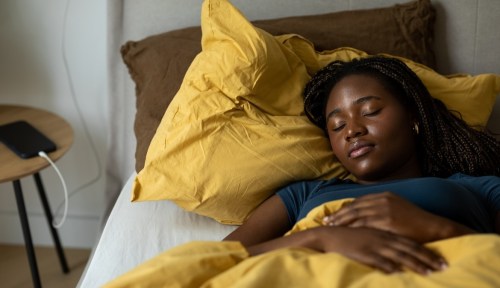Our editors independently select these products. Making a purchase through our links may earn Well+Good a commission
Depending on who you are and what your situation is, it’s possible that the pandemic has affected your life in any number of ways, including (but not limited to) how you work, eat, socialize, and even poop. It should come as no surprise, then, that it’s also changed sleep habits for many folks.
Experts in This Article
BJ Hardick, DC, is a chiropractor and nutrition expert based in Ontario, Canada. He is the author of the book, Align Your Health.
psychotherapist and founder of Manhattan Wellness
Exactly how it’s changed, though, depends on the person. According to a sleep survey of 1,000 people commissioned by Casper, 53 percent have been going to sleep later than usual or at an inconsistent time, and of respondents who share a bed with a partner, 14 percent reported that they’ve started sleeping in different beds. But one takeaway that’s especially surprising? Since March 2020, 69 percent reported the fetal position to be their favorite sleep position, which is way up from the estimated 40 percent from pre-pandemic times.
According to therapist and Manhattan Wellness founder Jennifer Teplin, LCSW, how we sleep can say a lot about our psyche. “I believe that everything is connected and that, as humans, how we do one thing is how we do most things,” she says. “It would make sense that the position we sleep in can be correlated with how we’re feeling emotionally.”
So what might it mean that more of us are curling our bodies inward at night during pandemic times? Below, Teplin gives insight, plus, a chiropractor shares how we can care for our spines best when opting for this sleep position.
Why sleeping in the fetal position is human nature during hard times
Put simply, sleeping in the fetal position can be an outward sign of wanting to protect yourself. “Similarly to general body language, when we’re feeling comfortable, our body ‘opens up.’ This means you may sleep with your body spread out,” she says. “When we’re feeling closed off or sad, our body may mimic this feeling by sleeping in a fetal position, or with our hands in fists or in a tight ball.”
“When we’re feeling closed off or sad, our body may mimic this feeling by sleeping in a fetal position, or with our hands in fists or in a tight ball.” —Jennifer Teplin, LCSW
Teplin adds that the fetal position is comforting to many people and it is an outward sign (whether consciously or subconsciously) communicating just that: needing comfort. “Whether we’re conscious of it or not, sleeping in the fetal position is one of the healthiest choices because it physically protects brains and vital organs,” she says.
So if you sleep in the fetal position, it may be a sign that you want comfort and protection—and amid this time when many are contending with compounding catastrophes, it’s no wonder the sleeping position has become the default for many.
What a chiropractor thinks of sleeping in the fetal position
Sleeping in the fetal position may fulfill an emotional craving, but it’s not necessarily great for the spine—especially for those who are already spending hours with their spine curved forward towards a computer. “There certainly is the argument that sleeping in the fetal position causes too much flexion of the entire spine,” says B.J. Hardick, DC, a chiropractor and author of Align Your Health ($28). “However, I’ve never seen a person be able to control what happens to his or her body when he or she is unconscious.”
So, despite the undesirable possible flexion of fetal-position sleeping, Hardick doesn’t recommend fighting the urge to sleep in such a way. “It’s my philosophy to not fight natural tendencies of the body if they are part of the body’s healing process,” he says.
So, rather than changing your sleeping position, Hardick recommends doing some full-body stretches before bed to counteract any potential unsavory effects of the fetal position—not only because stretching is good for the body, but also because he says it’s a great way to wind down before turning off the lights. He recommends patients stretch using a cervical roll ($17) for 10 to 15 minutes before bed as a way to show the spine some love. “At this time of day, the body is slowing down,” he says. “This is the ideal time to work on stretching the cervical spine and can be done regardless of the position in which a person will sleep.” (He caveats that this is only a strategy he recommends for someone working with a chiropractor who can demonstrate exactly how to do it.)
Don’t have a cervical roll or access to a chiropractor? As an alternative way to stretch, Hardick recommends doing some kneeling lunges to open up the hip flexors as part of your pre-bedtime stretch routine. “Most of us flex forward too much and tighten up those muscles on the anterior chain,” he says. “If there is just one stretch a person can do before bed, it’s this.”
And to emotionally stretch before bedtime, Teplin recommends coming up with a nighttime routine that incorporates your favorite forms of self care. Similar to a stretching routine, this will help the body wind down at the end the day while also providing comfort.
She also recommends sticking to a firm bedtime. “During times where we feel a lack of control, it’s important to identify what is within our control. When we go to sleep and when we wake up is a part of it,” she says. “Similar to childhood, a bedtime sets an expectation and is something you can rely on.”
Ultimately, though, if you find yourself sleeping in the fetal position and never used to, don’t worry. If curling up makes you feel safe and warm, relish in that comfort with luxurious sheets and blankets. With the pandemic stretching on longer than anyone could have predicted, finding comfort is key. And that includes how you sleep.
Oh hi! You look like someone who loves free workouts, discounts for cult-fave wellness brands, and exclusive Well+Good content. Sign up for Well+, our online community of wellness insiders, and unlock your rewards instantly.
Sign Up for Our Daily Newsletter
Get all the latest in wellness, trends, food, fitness, beauty, and more delivered right to your inbox.
Got it, you've been added to our email list.











